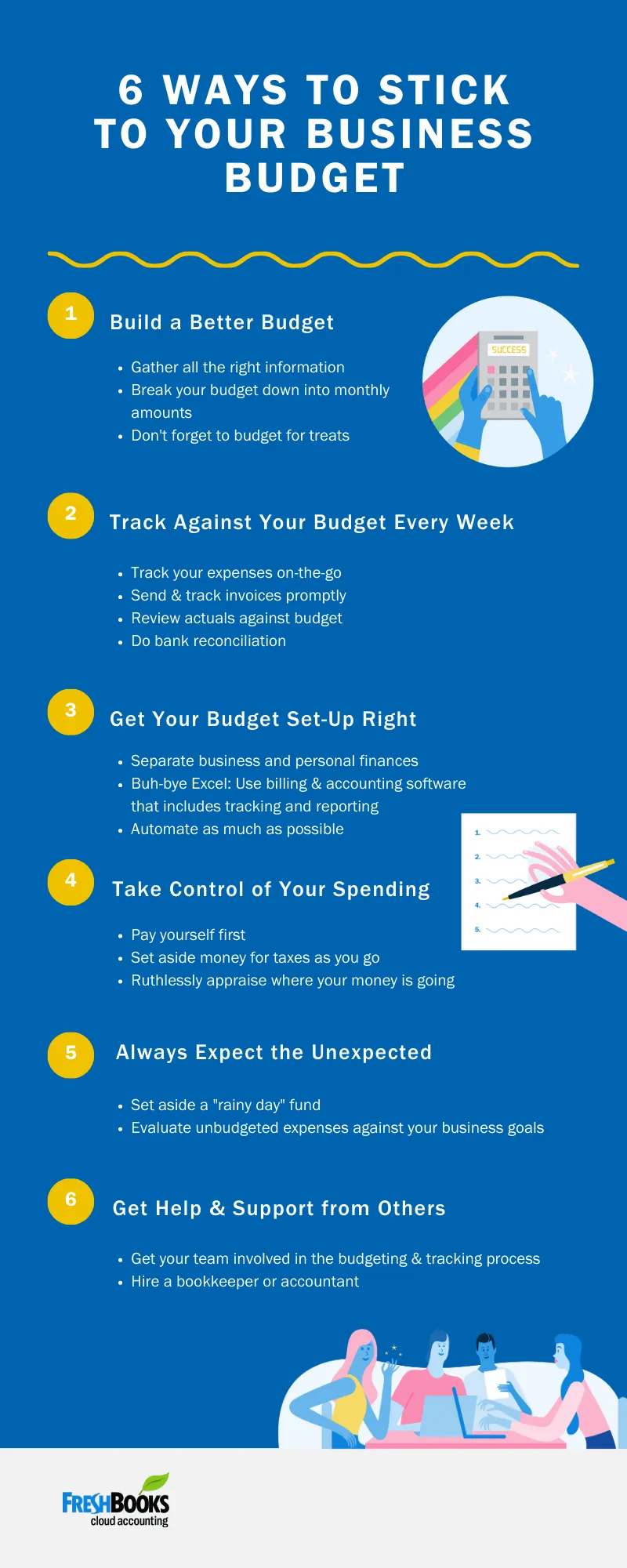Improve budget management and learn how to stick to a budget with these budgeting tips.

If you’re unsure about how to stick to a budget, you’re not alone. Many business owners work hard to create a business budget: They tally income sources, calculate expenses, predict future one-time spends, and put it together only to struggle with budget management and implementation.
Why is that? Why are implementation and management so difficult? More importantly, what can you do to ensure you better manage and stick to your budget?
Table of Contents
Why Business Owners Struggle with Budget Management
There are various reasons why business owners struggle to manage and stick to a budget. Unlike setting up a budget, implementing and managing one is a continuous process that can be difficult to maintain. It requires:
- Constant tracking and reporting
- Adjusting based on reality
- Measuring the accuracy of budgeted expectations to improve next year’s budgeting exercise
The good news is that you don’t have to struggle. Read on to learn how to improve budget management with these budgeting tips.
1. Build a Better Budget
Set up a Budget You Can Stick To
It goes without saying, proper budget management and implementation starts with creating a realistic budget you’re likely to stick to in the first place. Follow these five steps to create a balanced budget:
- Tally all your income sources to determine how much you make
- Incorporate your fixed costs by reviewing old bank statements
- Add any variable costs to your calculations
- Factor in all one-time purchases
- Add your income, fixed and variable expenses, and one-time purchases
For a deep dive into how to create a budget you can stick to, read Create a Small Business Budget in 5 Simple Steps.
Break Your Budget into Weekly or Monthly Amounts
If you look at income on an annual basis, it can feel like an unreal number to manage. To ground your budget in your daily reality, you need to change the view from annual to weekly or monthly.
Doing this makes your budget more manageable. You also become more financially aware of your spending and can identify early on if you’re going over budget. This, in turn, gives you ample time to identify budget shortfalls and adjust for them.
Budget for the Occasional Treat
If you don’t budget for the odd treat, frustration and resentment can build up, which may even lead to a spending binge and a blown budget.
So, instead of viewing your budget as a plan only to live frugally, see it as a blueprint that helps you get to grips with your spending habits and makes you a conscious spender.
Incorporating some “treats” in your planned spending will stop your budget from feeling like an enemy. It will also help you enjoy those “treat” moments without guilt or fear!
2. Track Against Your Budget Weekly
An effective budget is only as good as the information it contains. And, for that information to be valuable, you need to update it by tracking your income and expenses regularly, and capturing any changes as they occur.
Track Expenses
Imagine this: Month-end arrives with you over budget and unable to cover your bills. By tracking your expenses daily, you avoid these scenarios and can improve budget management by:
- Pinpointing your spending patterns—your spending categories and how much money you spend by category
- Creating more accurate future budgets by looking at all your past expense data
- Comparing actual spending against your budget to see if you’re on track (more on that later)
Track Invoices and Other Income
Tracking invoices helps you keep a firm handle on your income, so you can:
- Determine what you can afford
- Identify your income sources, across services and clients
- Pinpoint which clients and services generate the most income
- Better predict future monthly income by looking at past data
- Compare actual income vs. budgeted income (discussed next)
Pro Tip: When budgeting your income remain conservative and underestimate your monthly income to give you a margin of safety.
Review Income and Spending Against Budgets
By comparing your actual income and expenses against your budget, you can determine if you’re over or under budget and quickly make changes without a negative impact on business.
For example, let’s say you budgeted $2,000 / mo for business expenses, but soon discovered you underestimated by a few hundred dollars. You’ll now have to adjust your budget accordingly, i.e. increase one budget category at the expense of another.
Making adjustments like this, or even acknowledging your budget was unrealistic to start, is part and parcel of sound budget management. After all, budgeting will always involve some estimation and trial and error to get it down pat. Embrace it!
Do Your Bank Reconciliation
Bank reconciliation or “bank rec” is the process of comparing your cash balances against your bank statements to see if they match. Any discrepancies or differences will typically be recorded in the bank reconciliation statement.
A business will do a bank rec for many reasons—to achieve accuracy in accounting records, protect against fraud and prevent errors from transferring over to financial statements—but it’s often overlooked as a budget management tool.
Because bank rec involves keeping a close eye on all transactions, it provides a window into your spending habits and identifies where you can make changes to remain on budget.
Your bank reconciliation also gives you an accurate overview of how much money is in your business account at a specific point in time so you can quickly gauge if you’re on track to meet your budget.
3. Get Your Budget Setup Right
Sticking to and better managing your budget also depends on having the right setup, tools, and systems.
Separate Business and Personal Transactions
A big part of budgeting is predicting and tracking expenses. Unfortunately, many small business owners struggle to track their spending or even differentiate between personal and business expenses because they don’t have separate personal and business accounts.
The solution to this common side hustle money mistake is to have two separate checking accounts.
Use Accounting Software and/or Apps to Help You
When it comes to tracking income and expenses for budget management purposes, you can use spreadsheets like Excel or even cloud accounting software.
Using spreadsheets may seem cost-effective, but it’s time-consuming as you have to manually input expense and income information. You also invariably have to wade through endless bank statements to check the accuracy of your accounting records.
The point is: Tracking expenses and income in spreadsheets makes budgeting a cumbersome and challenging process.
The better approach is to use accounting software that simplifies expense and income tracking and helps you quickly identify your spending patterns.
The right software lets you monitor expenses without lifting a finger, so you always know how you’re spending your money. All you have to do is connect your bank account.
You can also access all your invoices and income from one place to see if you’re on track to meet your income targets and even drill down to income by client or project.
Finally, you can access dashboard summaries to view income and expense reports, which provide an at-a-glance overview of how your business is doing. Simply compare these reports against your budgeted amounts to gauge how you’re doing.
Get Your Bank to Automate Your Finances
Speak to your bank and arrange that the money you receive each month is automatically transferred to key pockets you’ve budgeted for: Investments, savings, and fixed costs (utilities, cell phone, subscriptions).
This automation removes the temptation to stop any payments and prevents you from overspending because the money leaves your account like clockwork each month.
4. Take Control of Your Spending
A big part of sticking to a budget is to control spending. You can do this by paying yourself first, setting aside money for Uncle Sam and aggressively evaluating your expenses.
Pay Yourself First
Paying yourself first means you assign a portion of your paycheck to be automatically transferred to a savings account each month.
You can use these savings for retirement, to build an emergency fund or for any other financial goals. The main reason to pay yourself first is to prevent overspending and ensure you save enough before any non-essential purchases and expenses.
Budget for Taxes
You need to set aside money for tax during the year. If you don’t, you won’t be able to pay Uncle Sam and you’ll be scrambling to scrape together the cash you need. That’s not to mention that your budget will be out of balance.
The solution is to budget for the tax dates. In the United States, the important quarterly tax dates are:
- April 15th
- June 15th
- September 15th
- January 15th
Make sure you set aside 20 to 25% of your income for tax for those dates.
Ruthlessly Appraise Expenses
A budget should capture expenses you can afford and justify. But there will be moments when you’re tempted to spend outside what’s included in your budget. Maybe you need new technology or software. Or, perhaps you have a large project that requires outsourcing.
Regardless of what that temptation may be, you need to understand you’ll have to trade budgeted expenses for unplanned ones—assuming estimated income is in line with actual revenue.
If actual income does not match your budgeted expectations, you may need to cut your estimated expenses. An excellent place to start is to eliminate unnecessary subscriptions you no longer use.
5. Always Expect the Unexpected
Plan for the rainy days because they will come. Unless you’re a clairvoyant, you can’t foresee and plan for absolutely every eventuality. But that doesn’t mean you can’t create a plan to handle any unbudgeted opportunities.
Budget for Unexpected Emergencies and Rainy Days
Service businesses like yours often experience fluctuations in income from one month to the next. These fluctuations can occur due to differences in workload—perhaps you lost a client, or seasonal changes—maybe you’re a landscaper with a marked quieter winter period.
Unplanned expenses also crop up. Maybe your car suddenly needs attending to, or you need a new laptop because the hardware failed.
You need to plan ahead and prepare for the above scenarios so you can cover your costs. If you don’t, you’ll be over budget and scrambling for excess cash.
One way to prepare is to include a line item in your budget labeled Emergency Fund. Then, make a point of transferring money into that account each month.
Set Business Goals that Let You Appraise Any Unbudgeted Opportunities
When opportunities arise that involve unbudgeted spending or investments, you want to be able to business case them. By setting clear business goals for the year and prioritizing them, you can do precisely that.
These goals become the benchmark you compare any opportunities against by asking yourself: Does the opportunity align with my business goals? If not, scratch it and move on.
For example, if one of your business goals is to get more clients, an unbudgeted opportunity to attend a client-rich networking event might be worth moving around money for. But an unbudgeted opportunity to buy discounted technology won’t be, because in this case it doesn’t align with your goal.
6. Get Help and Support from Others
The onus of better budget management does not have to sit only with you.
Involve the Whole Team
If you manage a team of employees, involve them in the budgeting process early on. Early involvement encourages employee buy-in, helps maintain budget accuracy and improves the odds of creating realistic budgets you will actually stick to.
Approach the right employees in specific departments to get the income and expenses numbers you need. For example, if you run an agency, speak to the account managers to get a breakdown of income and expenses forecasts by account. Because they work directly with the account, you’ll get a more accurate overview of income and expenses.
Work with a Bookkeeper or Accountant
The final tip for how to stick to a budget is to work closely with your bookkeeper and accountant. A bookkeeper and accountant are different, with bookkeepers mainly focused on recording transactions and accountants on recording, analyzing and interpreting data.
But, both work with your financial data and share the goal of improving your financial situation. They track revenue and expenses, create financial statements to help you make better financial decisions, and can even work with you to develop and manage budgets and forecasts.
A Final Few Words on Better Budget Management
Managing and sticking to a budget is a struggle for some because they simply cannot cope with the continuous tracking and adjusting that’s required.
But you needn’t struggle as long as you implement the right budgeting tips. This post explored six.
We cannot promise you that implementing these tips will lead to a totally smooth budgeting process from hereon in and that you will always stick to your budget.
But what we can promise you is that implementing some, or all, of these tips, will improve your budget management and make sticking to a budget just a little bit easier.
Have you implemented any of these budgeting tips? Please let us know in the comments below.
This post was updated in March 2021.

Written by Nick Darlington, Freelance Contributor
Posted on December 16, 2019

 Personal Finance Tactics From the Pros: How to Apply It to Your Growing Business
Personal Finance Tactics From the Pros: How to Apply It to Your Growing Business How to Create a Small Business Health Check Plan
How to Create a Small Business Health Check Plan Create a Small Business Budget in 5 Simple Steps
Create a Small Business Budget in 5 Simple Steps






